Total posts:
187
08/06/2008
August 6th, 2008 by Steve Ashby
Finally, finally, I get to the Vikings. This is where it gets interesting. But first we have to deal with the Middle Saxon period (c. AD 650-850). Some would say that the period between the end of the ‘Pagan’ period and the arrival of Scandinavian raiders and settlers is under-appreciated, and there is indeed much to learn about the archaeology of this period, and much that metal-detected data can offer.
The Middle Saxon Period
Northamptonshire is, as those of you who live there know (or should do) pretty centrally placed within modern England. That meant that between the 6th and 9th centuries, it fell within the lands controlled by the Kings of Mercia, of whom Offa (ruled AD 757-796) is undoubtedly the most famous. It’s worth dwelling a little bit on this period, because it’s something we Midlanders can be a little proud of (certainly, for some of us, its our greatest moment pre-May 16th 1987).
By the time of Offa, Mercia had extended its dominion over much of southern England. Offa founded a number of market towns in the region, began minting coins, and involved himself in the administration of the church. He held considerable authority, discernible through his commissioning of Offa’s Dyke, and through his negotiations with Charlemagne. Soon after the time of Offa, the pendelum of power swung in favour of Wessex, though the star of that county was also to be short-lived, given the imminent arrival of Scandinavian raiders, settlers, and mercenaries.
So much for the history. As for the archaeology of settlement, by the Middle Saxon period, land was divided into major logistical units, within which centres developed. In Northants, Hamtun (Northampton) was a key example, and in AD 750 a great hall’was constructed there. Excavations on St Peter’s Street recovered what was at first thought to be a Saxon palace , but is perhaps more properly described as part of a minster complex.
So what can the PAS add to this picture? Well, a search of early medieval finds in the county brings up a number of 8th and 9th-century strapends and similar dress fittings. The value of these finds is in their spatial analysis, both on a county and national scale, but that’s for another day. In addition to these finds, there are a few more unusual objects, such as this decorative sword pommel (which might be indicative of an elite presence and/or military activity in the area), and this pin beater (a tool used for beating weft when weaving textiles). Early medieval swords and associated objects are not common finds, while bone tools are reasonably well known from urban excavations, but less so as spotfinds.
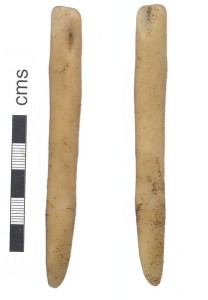
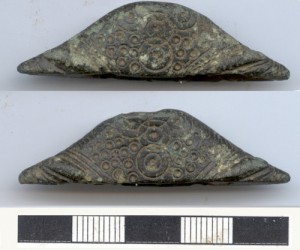
Of course, the other thing we shouldn’t forget about are coins. We have 9 sceattas from the county, including this unusual (probably continental) variety. Their distribution remains to be analysed, but when we have a few more examples it may tell us a lot about settlement and market activity in Northamptonshire.
Here come the Vikings!
As I alluded to above, the Kingdom of Mercia collapsed in AD 873 with the invasion of the Danish Great Army, traditionally thought to have been led by Halfdan Ragnarsson, Ivar the Boneless, and Ubbe Ragnarsson. Later, following an eventual agreement between King Alfred the Great and Guthrum the Old, leader of the East Anglian vikings, it was agreed to divide ‘England’ (much of which was not Alfred’s to give) up into ‘Danish’ and ‘Saxon’ halves (along a line running roughly between London and Chester). In our part of the world, Watling Street (which runs right through the county, and is today marked by the line of the modern A5 road through Towcester and Daventry) was taken as a convenient and easily understood boundary, with the land to the south and west of this remaining under Alfred’s control, and that to the north and east of this becoming de facto Danish.
So, in theory Northamptonshire was cut in two, with the land west of the A5 being ‘English’, and the rest of the county being ‘Danish’. Now, it’s not as simple as that, and we know from archaeology, linguistics, and history that the two communities did not remain isolated from one another, and by the 10th century England can be said to have developed an Anglo-Scandinavian character.
On the other hand, how true was this in the 9th century? It would be interesting to see if there is much evidence of factionalism and division when this area was first divided up. Was the boundary really always more political than real, or was there a period when settlers really were forced to live on one side or another of the boundary according to their perceived ethnicity of allegiances? If so, at what date (and why?) did this begin to change? The reality of the Danish presence in north Northamptonshire is shown by the concentration of place names ending by and thorpe, and the way in which the historic parishes tend to butt up against the line of Watling Street is suggestive of its longheld significance as a boundary, as well as a medium of communication. However, it is through archaeology, and through everyday finds such as dress accessories in particular, that we might be able to find out more about Norse-native contact and cultural identity in the early Viking Age. So, it would be useful to know whether detectorists and members of the public are finding many 9th and 10th century objects of true Scandinavian character, of true ‘Anglo-Saxon’ design, or cheap imitations of either. So let us know about your Jellinge brooches, cloissonne brooches, Winchester style strap ends and nasty bits of early medieval lead.
‘But what do we have so far?’, I hear you ask. Well, there’s not an awful lot of late Saxon/Viking Age data for Northants at the moment, but what there is I hope to publish in the near future. For the time being, here’s a taster of some of the bits and pieces that have come up.
As I mentioned above, there are a number (c.30 at the time of writing) of ‘Saxon-looking’ strapends (see this one, for example ) though in many cases it is difficult to say whether these date to the 9th century or earlier. More definitively Viking-Age is this distinctive Jellinge style disc brooch which perhaps represents the presence of someone who had travelled over from southern Scandinavia, or a local attempt to look as such (a lug on the reverse suggest that it may have been used as a pendant, which is perhaps indicative of a true Scanbdinavian origin). Further research is required in this area (and I intend to do as such!).

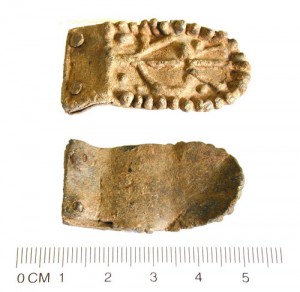
Lead alloy strapend
In 10th and 11th-century England, we see the copying of Scandinavian styles of jewellery and dress accessory in cheaper materials, From South Northants, we have this lovely (and naff) lead strapend. The period also sees the development of distinctive ‘hybrid’ forms of material culture, known as the Anglo-Scandinavian and Hiberno-Norse schools. The latter is represented by distinctive ‘Norse bells’, which seem to come originally from the Irish Sea area, and may have been dress accessories, or could perhaps have had a role in falconry. There is a good example from South Northants, which is all the more interesting as its decoration is not typical of the type.
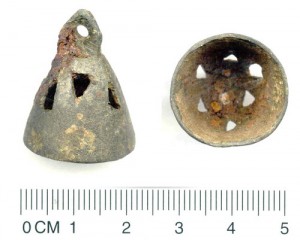
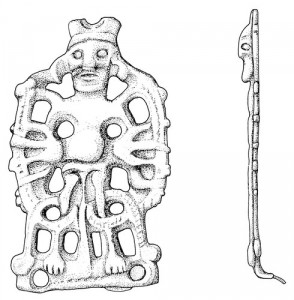
08/01/2008
August 1st, 2008 by Steve Ashby
Hello! Yes, it’s me, Barry Scott. Rapidly following on from last week’s Roman extravaganza, I thought I’d give you a brief introduction to what we’re finding out about what archaeologists refer to as the sub-Roman and Early Saxon periods.
The conventional wisdom is that following departure of the Roman legions (historically dated to AD 410), the infrastructure of Roman Britain rapidly disintegrated coins fell out of regular use, roads became potholed, overgrown, and eventually unused, and the effort required to maintain many villas was seen as unworthwhile. Don’t say that to my colleague, Rob Collins though. The long and short of it is that something (or nothing) happens in the immediate post-Roman period, and at the moment, we don’t know what that something or nothing was. Answers on a postcard. Before we get onto the PAS data, I’ll very quickly review some of what we know about settlement, agriculture, industry, and religion in the period of interest. Then we can get on to thinking about how PAS data can help to answer these questions.
Settlement and Agriculture
In Northants, extensive survey work carried out by Northamptonshire Archaeology in the east of the county shows evidence for population decline following Roman withdrawal, with a decrease in the density of settlement, an apparent dereliction of previously cultivated land, and the regeneration of woodland. Nonetheless, there is still much to learn about the rreasons for this trend, the means by which it happened, and the importance of egional variability. Together with traditional archaeological excavation and environmental research, PAS data can help clarify the important issues associated with this time period. Because our data is dominated by metalwork, we may miss some of the finds recovered by archaeological excavation, but our rural focus also means that we are working in areas many other archaeologists are not. It is only through bringing together these diverse sources of data that we can hope to understand what was going on in this poorly understood and understudied period.
However, the issue of the importance of the arrival of settlers from Anglia, Saxony, and Jutland is in many ways as contentious as that of the Roman withdrawal, and one in which metal-detected data may be able to play a more central role. How much of ‘Anglo-Saxon’ culture actually owes its existence to these settlers, and how important were the remaining native Britons? We can’t agree on the numbers of settlers, even in vague terms, and this is an issue that detecting may once again be able to help with; let us know when you’re finding Late Roman buckles or Anglo-Saxon brooches, and we will be better equipped to answer these questions. Even pay attention to grotty bits of pottery; there are some of us that love late Roman and early medieval ceramics (yes, honestly).
Industry
Taking a lead from their Roman forebears (and this is one of the hints at continuity following the AD410 military withdrawal) the inhabitants of Anglo-Saxon Northants developed a significant iron smelting industry, which was to last well into the Late Saxon (Viking) and medieval periods. Now, this is perhaps an area best left to the archaeologists, as the identification and dating of iron waste is a tricky (nigh impossible) task when context data is not available, and the constant pinging of iron slag is not a sound coveted by many detectorists. Base metal and ceramic industries were also important, and the recognition of local variation in these crafts is only identifiable through the collection of large numbers of artefacts with good findspot data. So we’d really like to know about any objects you do find. Some examples of the sorts of things that have already been recorded with us are given below.
Religion
To put it simply, paganism (for wont of a better term) seems to have ruled in Northamptonshire between the 5th and late 7th centuries, with over 50 pre-Christian cemeteries known. The artefacts found in these burials, including the ceramic urns used in cremations, and brooches and dress accessories deposited as grave goods in inhumation burials, seem to indicate that the settlers of Northamptonshire had diverse origins within Germanic Europe. The move to Christianity is a complex one, and one we’ll save for a future blog entry.
Summary
All of this evidence comes from a mixture of historical sources, excavation, geophysics, fieldwalking, conjecture and educated guesswork. What can metal detected data actually add to the picture?
Well, one area in which it shows great potential is in understanding the importance of tribal identities and regionality in post-Roman Britain. Recent work by Stuart Laycock on the distribution of late Roman and early Saxon metalwork has led him to suggest that Britain after the Romans was a complex, ununified system of tribes and enclaves; a picture perhaps analagous to the Balkans in the late 20th century. Such a scenario would be easily exploited by invading Angles, Saxons, and Jutes. This idea is not yet proven, but metal-detected data has played a fundamental role in its development, and will continue to be important in discussion and debate around the subject. What was the situation in Northants, part of the region dominated by( prior to the Roman arrivals, and perhaps after their withdrawal) a tribe known as the Corieltauvi, for example? We need more research to find out, so please keep recording your finds with us, with as precise findspot data as possible.
Supporting-Arm Brooch
The first evidence of migrants comes from a couple of very early, continental-style brooches. This supporting arm brooch dates to around the late 5th-century, and clearly still wears its Roman influence on its sleeve. Importantly, it is a rare type in Britain, but is more well-known in the Germanic homelands of Schleswig-Holstein, northern Germany. Tantalisingly then, it might therefore have arrived in Britain on the clothes of one of the first Anglo-Saxon settlers.
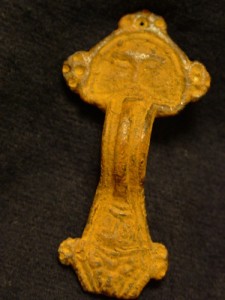
Radiate-headed Brooch
Slightly later in date is this radiate-headed brooch, which dates to around the 6th-century, and has its closest parallels in continental Europe. It may betray a Frankish influence in the area. Though it is difficult to prove as much on the basis of a single find, it does raise the question. As such, the archaeological importance of recording these metal-detected artefacts and their findspots is clear. When we have enough data to map it, distribution analyses may considerably chnge our understanding of life and death in Northamptonshire in the wake of the Roman withdrawal and the first years of Germanic settlement.
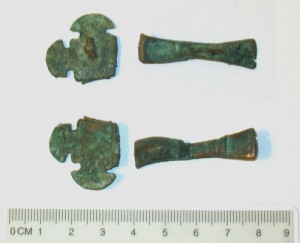
An Anglo-Saxon Small-Long Brooch from Northamptonshire
From the main period of the Early Anglo-Saxon period, we have a number of suggestions of Anglo-Saxon cemeteries, and others which are probably related to previously known (and now sadly largely lost) gravefields. That is, if we can take these brooches as evidence of cemeteries; perhaps some are chance losses related to settlement activity and travelling? This suggestion has been made by the Anglo-Saxon brooch project, run by our former Kent FLO, Andrew Richardson and Laura MacLean (Essex FLO).
Similar research is being undertaken by a number of archaeologists, not least our own Drs Kevin Leahy and Helen Geake. I’m sure details will appear here as various projects progress.
07/29/2008
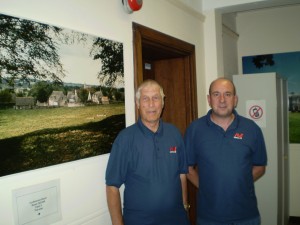
Dave and Tim
Given that we’ve just had National Archaeology Week (soon to become the Festival of British Archaeology), and the web is full of pictures of children getting involved in archaeology, I thought you might be interested in what the PAS do. You already know about much of our outreach work with schools and after-school groups (see our annual reports for specific examples), and our PASt EXPLORERS website, but I thought you might be interested to hear about what detectorists themselves are up to.
So, here’s a nice little story, relating to two of Northamptonshire’s star finders. Tim Binns and Dave Derby are a couple of prolific detectorists, and have been regular recorders with both me and my predecessor,Tom. Dave has been detecting for 30 years, while Tim has been at it for five years, but both are extremely dedicated to responsible detecting, always recording with good findspot data (often with a GPS, at up to 12 figures), and always with an eye to the archaeological importance of any find or site. They really do present an excellent example of the kind of practice that the PAS tries to promote.
As I’ve said, Dave and Tim always record their finds with the local FLO (yours truly), and I provide them with a printout of the database report and photograph. They have both had some lovely, and archaeologically important finds, but of course, not everything is equally impressive to look at, and for us, the value of many finds is in knowing about where they came from. Anyway. just a few weeks ago, I learned something about what happens to many of the less impressive finds, after I return them to Dave and Tim. In many instances, they donate their finds to local schools, and use the finds reports to explain what the objects are. I thought this not only an extremely generous gesture, but also one that has really positive implications for archaeology and education.
Do you remember your history lessons at school? 1066, 1415, 1588, 1605, 1666 etc etc etc… Just imagine how much more fun they would have been if you could have touched real objects from the past – simple things like Roman and medieval coins, brooches, and military badges would make all the difference. And imagine if you could have ago at being an archaeologist (or a FLO!), drawing, measuring and weighing these objects, and trying to identify them based on what they looked like.
Through their generosity, that’s exactly what Dave and Tim have helped to put in place. Just think- have you got piles of worn Roman grot, or broken pieces of brooch in your scrap box that you never look at? Why not try following Tim and Dave’s lead, and take them along to a local school or youth group. Of course, we would like to record anything first, so that there’s a permanent record for researchers and the general public, and that record could then be used to help children learn. Go on, have a think about it.
Well done Tim and Dave! It’s great to see Northants detectorists leading the way!
07/23/2008
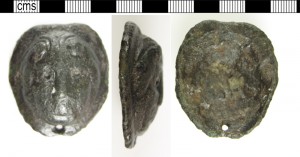
A detectorist has recently donated a really interesting find to National Museums Liverpool. It was found in the Hale area of Cheshire which is just outside Liverpool. It’s locality makes it more important as north of the River Mersey finds are not abundant- especially finds as nice as this one. This find will hopefully go into the new Museum of Liverpool which is planned to open in 2010
The find is a face mount, from furniture or a vessel. It is Roman in date but has Celtic influences in it’s design. It is recorded on the database as LVPL-1DBDD5. It is a female face, representing Medusa, one of the Gorgons, and the only one who was mortal. Her gaze could turn whoever she looked upon to stone. There is a particular myth in which Medusa was originally a beautiful maiden. She desecrated Athena’s temple by lying there with Poseidon. Outraged, Athena turned Medusa’s hair into living snakes. Medusa is represented as a fierce female nearly always with a frontal rather than a profile head. She was often used as an apotropaic amulet.
07/18/2008
Hello again! We’re back with a review of the data from Roman Northants; thanks again to my assistant Katie Robbins for all her backgound research.
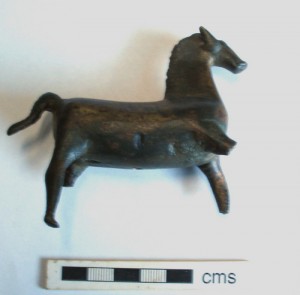
Roman Horse Figurine
During the Roman period (traditionally dated AD 43-410), Northamptonshire sees considerable expansion in several areas of life and commerce, including the intensification of agricultural production, the establishment of craft and industry, the construction of road networks and the foundation of market settlements and religious centres.
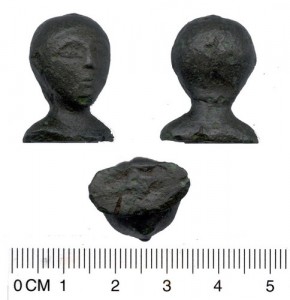
Roman figurative bust
Small towns developed at Towcester, Titchmarsh, Kettering and Duston, all bound together by the expansive Roman road network. The identification of earlier settlement activity at many of these locations suggests that these Roman roads often followed the routes of prehistoric pathways (another issue that controlled and targetted detecting and reporting might help to address). Other nucleated settlements were scattered throughout the county, and rural settlement in particular shows interesting patterning. Many ‘non-villa’ rural settlements seem to have been abandoned or transformed with the coming of the Romans, perhaps reconstructed in rectilinear forms around trackways and ditched enclosures. For example, in in the north-east of the county, the 2nd century saw the replacement of Iron Age round houses by aisled buildings and villas. However, in central and south Northamptonshire, these typically Iron Age constructions continued to develop alongside the newly introduced row-type villas. This distinction raises important questions about the nature of settlement and identity in different parts of the county; are we seeing discrete local political situations and identities? And could metal detected finds help to clarify what was going on?
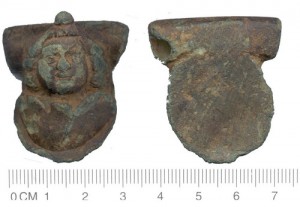
Roman vessel mount
Whatever the explanation of this local variation, villas are fairly well known right across the county, though there is considerable variation in morphology. Building types range from large, complex constructions to much smaller, simpler affairs. Agriculture, trade and industry blossomed in Romano-British Northants, and this is again an area in which detected finds might be informative. In addition to more traditional crop farming, there is evidence for grape-growing (presumably for wine), while the local ceramic and quarry-stone industries were also important. However, perhaps most notable is the importance of the iron industry, and parts of the county may have been reponsible for extraction of much of the ore required to run the regional and military economies of Roman Britain.

Roman amphora strapend
Moving away from the practicalities of day-to-day living, we also know alittle about the beliefs of the inhabitants of Roman-British Northants. A number of possible religious sites have been identified, and detected finds such as figurines, votive axes, or objects bearing Christian iconography (such as the Chi-Ro symbol) might be clues as to the presence of such shrines or temple sites.
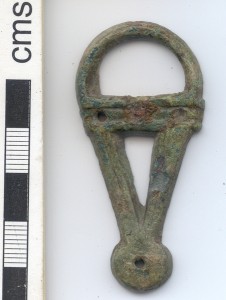
Late Roman buckle and openwork plate
In short, Roman Northants is probably better understood than its prehistoric counterpart. We know of a number of towns in the county, and archaeology – in some cases undertaken with the co-operation of metal detectorists – is helping us to answer a lot of important social and economic questions. However, the countryside is more poorly understood; we have lots of villas and small settlements in the county, but what was going on between these sites, and how were people moving though the landscape? Obviously the major roads like Watling Street played an important role, but surely there were many smaller trackways and meeting points that we don’t know about. Conceivably, metal detected finds, when properly provenanced with findspot details, can help us to identify some of these sites.
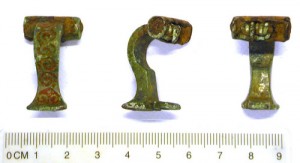
A Roman Enameled Knee Brooch
A good example of this is provided by the data that came out of last year’s rally at Islip – more on that later if I get around to it! In the meantime, here’s a quick run through of some of the most exciting finds we’ve had.
We’ve had lots of Roman finds from the county; they are far and away the most numerous of all the things I see. Unusual decorative items include this unusual (presumably ritually depsoited ) equestrian figurine from Brigstock [NARC-81AAB5], this bust (which may perhaps be the anthopomorphic butt of a knife handle) from Nether Heyford [NARC-E6A001], and this mount [NARC-9BBD94] from Titchmarsh. The precise functions of all are unclear, but both display asethetic qualities and are suggestive of specialised manufacture. Dress accessories such as brooches are more commonly found; nice examples include this enamelled knee brooch [NARC-96E378] from Norton, this ‘amphora-shaped’ strapend from Moulton [NARC-DF98F1], and this lovely late Roman military buckle from Hinton-in-the-Hedges [NARC-C6E5B8].
However, perhaps the star of the last few years is this rather unassuming nail cleaner from the Daventry area, which thus far is unparalleled anywhere in Europe [NARC-733D28].
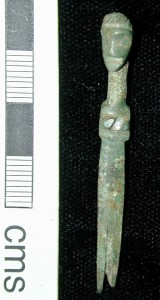
Unusual Anthropomorphic Nail Cleaner
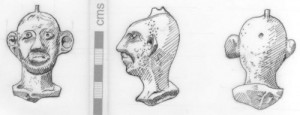
There was also an amazingly intricately cast steelyard weight [NARC-8D6343] from Paulerspury, which, together with a number of similar (if less ornate) PAS finds, and artefacts from excavations as several villa sites around the county, stands as testament to the importance of trade in the region.
On the subject of trade, let’s not forget the coins. Quite apart from all the ‘grot’ (as the number of Roman coins from Northants to date stands at 3351 records, it is really starting to provide an invaluable resource for understanding economy and settlement in Roman Northamptonshire), we’ve had one or two coins that are notable in aesthetic and numismatic terms, including unusual nummi ([NARC-8CF536] and [NARC-78D771]), and rare silver denarii of Marc Antony [NARC-E2D310] and Antoninus Pius [NARC-A3E503].
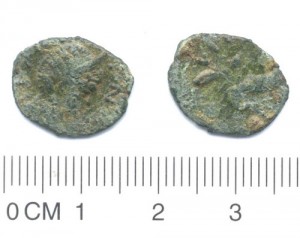
Recently, we had this unusual barbarous coin, copying a radiate of Salonina (wife of Gallienus). There is only one coin like this in the entire Cunetio hoard! It might not look like much to most of us, but Sam, the PAS’s coin guru at the BM, picked it out. So please don’t forget to show us your grot! Bring it in, bring it in, bring it in!
07/17/2008
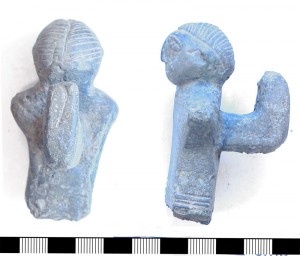
This is a really nice case of where an archaeologist spotted a find on UKDFD and, realising it was an important find, asked the detectorist to show it to his local FLO so they could record it. They promptly did this and now we have another really interesting find recorded for all to see.
It is a copper alloy Roman tripod mount. 2 of these have previously been recorded on the PAS database [LIN-1632D1] and [YORYM-EC06D2] but both of these are very different in style to the one brought into me at Manchester. They both depict Romanised gods (Bacchus and possibly Harpocrates respectively). The North Yorkshire one (recorded as [LVPL-CB8B04]) does not seem to be representative of anyone in particular and the design style used on it is much more reminiscent of Celtic art than the more fancy Roman design on the other 2.
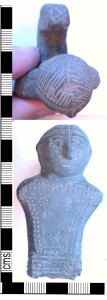
This is not to say it is cruder- just that it is different. It is probably more interesting than the other two because of its design. It shows a Roman object (the tripod) was not only being used by British people but that they were making this object and altering it to fit into their art styles. These are not common finds in
Britain and this appears to be the first in this style to be found. There are other tripod mounts known from excavations both in Britain and from the continent (Belgium and Germany) but these all seem to be similar in style to the other two mounts recorded on the database.
This shows just how important it is that we all collaborate to record finds- without the metal detectorist we would not have been shown this find and now have the information. In turn the metal detectorist now knows much more about his object than before.




















